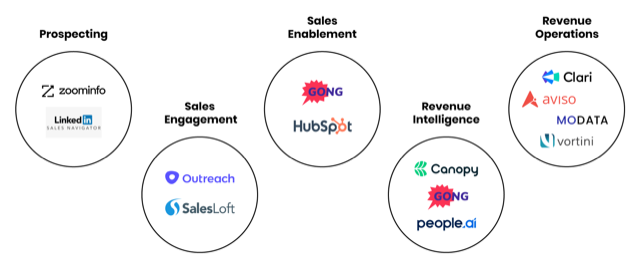
What’s Missing From Your Best-of-Breed Sales Tech Stack
In a year like 2021, assembling a so-called best-of-breed tech stack for sales is top-of-mind for probably every sales ops leader worth their salt. But it’s no easy task, especially when you consider the multiple categories (and sub-categories) of technologies that interact across complex B2B sales cycles.
You can end up with a laundry list of tools and apps:

There are thousands of different applications sales ops leaders can choose from to build their tech stack. So, what’s the best way to go about building one?
The short answer: whatever works for you. Forget the idea of a single “perfect tech stack,” because, unsurprisingly, there’s no such thing. Depending on factors like your product portfolio, sales region, sales strategy, customer segmentation, company size, and budget, you’ll find solutions that suit your needs better than others.
As a rule of thumb, for a new tool to be incorporated into your stack, it should do at least one (and ideally all) of these things:
Help you win faster, by accelerating your sales cycle
Help you win smarter, by automating repetitive tasks, eliminating low-value work, and giving you more control over your business
Help you win more, by intelligently guiding both sales managers and reps at every step of the sales process
Now, the point of this blog is not to give you a comprehensive list of solutions you should buy for your sales tech stack. That’s what others have done before us. But, if you feel haunted by the sheer endless choice of sales technology, where every vendor claims to be better than the others, this blog is an invitation to take a step back and look at the bigger picture.
Dashboards don’t solve problems
As technology evolves to serve increasingly niche purposes, it's tempting to build a large best-of-breed stack that optimizes for every possible step. Companies have spent billions on software to digitize and automate their sales processes over the last few years.
And while sales analytics software vendors like Tableau or InsightSquare have started to extend their features and integrate with many CRMs and desktop applications to provide greater customer value, they still don’t go far enough. Yes, all these technologies give you deep insights into static KPIs in their specific sales tech category. But they still don’t tell you which execution gaps in your sales process influence these KPIs. They remain analytical software tools that provide smarter reports but are useless when it comes to helping you understand what’s going on under the surface.
So the secret sauce is not just to get great, best-of-breed tools for engagement, enablement, forecasting, pipeline management, analytics, etc. It’s finding a way to incorporate these tools into and understanding their impact on your daily sales execution. (We discuss this in more detail in our guide, We Need To Talk About Sales Execution — especially the widespread misconception that a CRM will help to fix broken sales processes.)
Because only when you know what’s creating friction in your process on a day-to-day basis — even those fluid parts of the business that are difficult to nail down — can you choose the right tools and take the right actions to fix them.
In other words: Knowing your outcomes is good, improving them is better.
The missing piece in your sales tech stack is really a missing layer
Don’t get us wrong: we’re not saying you should get rid of or replace all the tools in your tech stack. After all, they provide crucial information about your prospects, accounts, and reps. But more often than not, they just don’t solve your execution problems, leading to low adoption, and a waste of time and money.
To meaningfully improve sales execution, you need a more actionable way of optimizing your process. You need a system that’s built to understand and fix the gaps in your day-to-day operations in real time.
That’s exactly what the Celonis Execution Management System (EMS) does. For sales, the Celonis EMS powers the Opportunity Management Execution App, which extracts and combines all your sales data from all your different sales technologies into a single platform, giving you a clear picture of how your sales activities are interconnected and influence each other.
When you break your sales data silos in this way, you can move from providing 'autopsies' at the end of the quarter to acting in real-time before the chips have fallen. Piecing the whole sales process together, you’ll finally understand what action is best for which opportunity at which moment in time.
The EMS is the intelligent layer for your sales tech stack
A good way to demonstrate the value of EMS is to show the flow of a sales process. In an ideal world, the process is a straightforward one. You create the opportunity, move it along the funnel, create a quote, commit, and win. However, in reality, your system complexity causes friction, preventing sales organizations from operating at full execution capacity. You can use all the sales tech you like, but if they don’t identify and fix the gaps in your sales execution in real time, all your optimization efforts go in vain.
But if you’re able to add that unifying, intelligent layer, suddenly everything starts to work together.

Before, all you could do was reporting on snapshot moments, with no visibility beyond the immediate next step. Now, you can analyze your end-to-end sales process and understand how your decisions will impact the top line. This is what we mean when we say that revenue is a process, not just an outcome.
Build your sales tech stack on the right foundations
The sales tech landscape is becoming increasingly crowded and complex — and that’s not a bad thing in itself. We strongly encourage you to build out your best-of-breed sales tech stack and find the solutions that meet your needs the best.
But for your sales tech to make a difference, you first need to understand the gaps in your sales execution, before adding the right tools to fix them. With the Celonis EMS in place, you’ve got a solid foundation to:
Understand how your go-to-market activities interplay (from campaigns to account info to BDR calls)
See where you have gaps in your process
Select the right technologies to solve these gaps and integrate these tools into your sales execution
Now you’re ready to build a tech stack that’s so much greater than the sum of its parts.
To find out how Celonis can help you maximize sales execution, check out the demo or read our eBook We Need to Talk About Sales Execution.




